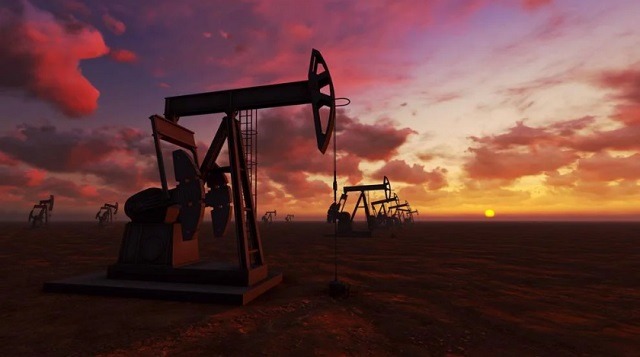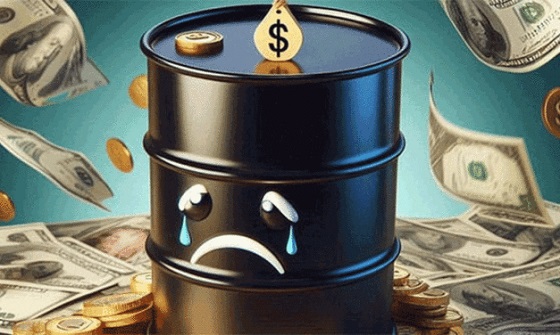Energy
Texas oil and natural gas production reached new record highs in July

From The Center Square
By
Texas’ oil and natural gas production reached new record highs in July, after breaking records in May.
Texas’ energy exports and production of natural gas liquids (NGLs) also broke records, according to new monthly energy economic analysis by Texas Oil & Gas Association.
TXOGA’s projections show that Texas set new records for crude oil production of 5.76 million barrels per day (mb/d); natural gas marketed production of 32.8 billion cubic feet per day (bcf/d); and natural gas liquids (NGLs) production of 3.85 mb/d – each setting record highs.
Texas’ petroleum value chain highlights for May 2024 also achieved records. Refiner and blender crude oil net inputs (5.69 mb/d) were the highest on record when evaluating EIA data that goes back to 1981.
Texas now accounts for 42.8% of all U.S. crude oil production and 28.3% of all U.S. natural gas marketed production year-to-date through July 2024, according to TXOGA estimates.
“The Lone Star State’s oil and natural gas industry is not only producing more, but doing so with unmatched efficiency,” TXOGA President Todd Staples said. “These latest numbers further reinforce the industry’s ongoing commitment to utilizing the latest technologies and innovations to produce abundant, affordable, and reliable energy.”

Texas exported $95.7 billion worth of energy products in the first five months of 2024, according to U.S. International Trade Commission data.
Texas exported $10 billion of crude oil primarily to Asia and Europe. Texas also exported nearly $6 billion worth of refined petroleum products, primarily to North America, Latin America and the Caribbean.
Natural gas exports accounted for $1.6 billion and hydrocarbon gas liquids, $2.2 billion.

Texas production records “underscore Texas’ dominant position in the U.S. energy market and ongoing contributions to national energy security,” TXOGA says.
While several news outlets have claimed oil and natural gas production records are a credit to Biden-Harris administration policies, those in the Texas industry point out that production records wouldn’t exist without Texas setting them.
Texas is leading in production because of a supportive state government and regulatory environment and facilities that primarily operate on private land, Texas industry experts have told The Center Square.
The Institute for Energy Research has identified over 200 actions the Biden-Harris administration has taken against the U.S. oil and natural gas industry, including halting federal onshore and offshore permits and leases, hamstringing production in other states.
As the Biden-Harris administration has advanced restrictions and threatened to tax and fine the industry, Texas Gov. Greg Abbott, the Texas legislature, state comptroller and the Texas Railroad Commission have implemented measures to facilitate production and safeguard the industry from federal actions.
While permits are held up by federal agencies, the RCC, which regulates the Texas oil and natural gas industry, continues to approve permits and implement conservation efforts, The Center Square has reported.
As the federal government advances investment policies targeting the fossil fuel industry, Texas law prohibits financial companies from implementing them and prohibits state government entities from investing in them.
Texas is also aggressively suing the Biden-Harris administration on several fronts. These include efforts to block EPA methane rules that would hamper the natural gas industry and blocking an attempt to classify lizards as endangered in the Permian Basin, one of the richest oil and natural gas fields in the world, among other policies.
Identifying threats posed by the current administration, those in the Texas industry have called on Congress to pass permitting reform, among other measures, The Center Square reported.
Staples also maintains that Texas’ production records “are not guaranteed. We cannot take for granted that this industry can continue to rewrite its record book in the face of federal policies blatantly designed to undermine progress. Delayed permits, canceled pipeline projects, closed and delayed federal leasing programs and incoherent regulations hurt American consumers and stifle our ability to deliver energy freedom and security around the world.”
Energy
75 per cent of Canadians support the construction of new pipelines to the East Coast and British Columbia

-
71 per cent of Canadians find the approval process too long.
-
67 per cent of Quebecers support the Marinvest Energy natural gas project.
“While there has always been a clear majority of Canadians supporting the development of new pipelines, it seems that the trade dispute has helped firm up this support,” says Gabriel Giguère, senior policy analyst at the MEI. “From coast to coast, Canadians appreciate the importance of the energy industry to our prosperity.”
Three-quarters of Canadians support constructing new pipelines to ports in Eastern Canada or British Columbia in order to diversify our export markets for oil and gas.
This proportion is 14 percentage points higher than it was last year, with the “strongly agree” category accounting for almost all of the increase.
For its part, Marinvest Energy’s natural gas pipeline and liquefaction plant project, in Quebec’s North Shore region, is supported by 67 per cent of Quebecers polled, who see it as a way to reduce European dependence on Russian natural gas.
Moreover, 54 per cent of Quebecers now say they support the development of the province’s own oil resources. This represents a six-point increase over last year.
“This year again, we see that this preconceived notion according to which Quebecers oppose energy development is false,” says Mr. Giguère. “Quebecers’ increased support for pipeline projects should signal to politicians that there is social acceptability, whatever certain lobby groups might think.”
It is also the case that seven in ten Canadians (71 per cent) think the approval process for major projects, including environmental assessments, is too long and should be reformed. In Quebec, 63 per cent are of this opinion.
The federal Bill C-5 and Quebec Bill 5 seem to respond to these concerns by trying to accelerate the approval of certain large projects selected by governments.
In July, the MEI recommended a revision of the assessment process in order to make it swift by default instead of creating a way to bypass it as Bill C-5 and Bill 5 do.
“Canadians understand that the burdensome assessment process undermines our prosperity and the creation of good, well-paid jobs,” says Mr. Giguère. “While the recent bills to accelerate projects of national interest are a step in the right direction, it would be better simply to reform the assessment process so that it works, rather than creating a workaround.”
A sample of 1,159 Canadians aged 18 and older were surveyed between November 27 and December 2, 2025. The results are accurate to within ± 3.5 percentage points, 19 times out of 20.
Business
Geopolitics no longer drives oil prices the way it used to

This article supplied by Troy Media.
Oil markets are shrugging off war and sanctions, a sign that oversupply now matters more than disruption
Oil producers hoping geopolitics would lift prices are running into a harsh reality. Markets are brushing off wars and sanctions as traders focus instead on expectations of a deep and persistent oil glut.
That shift was evident last week. Despite several geopolitical developments that would once have pushed prices higher, including the U.S. seizure of a Venezuelan crude tanker and fresh Ukrainian strikes on Russian energy infrastructure, oil markets barely reacted, with prices ending the week lower.
Brent crude settled Friday at US$61.12 a barrel and U.S. West Texas Intermediate at US$57.44, capping a weekly drop of more than four per cent.
Instead of responding to disruption headlines, markets were reacting to a different risk. Bearish sentiment, rather than geopolitics, continued to dominate as expectations of a “2026 glut” took centre stage.
At the heart of that outlook is a growing supply overhang. The oil market is grappling with whether sanctioned Russian and Iranian cargoes should still be counted as supply. That uncertainty helps explain why prices have been slow to react to a glut that is already forming on the water, said Carol Ryan, writing for The Wall Street Journal.
The scale of that buildup is significant. There are 1.4 billion barrels of oil “on the water,” 24 per cent higher than the average for this time of year between 2016 and 2024, according to oil analytics firm Vortexa. These figures capture shipments still in transit or cargoes that have yet to find a buyer, a clear sign that supply is running ahead of immediate demand.
Official forecasts have reinforced that view. Last week, the International Energy Agency trimmed its projected 2026 surplus to 3.84 million barrels per day, down from 4.09 million barrels per day projected previously. Even so, the IEA still sees a large oversupply relative to global demand.
Demand growth offers little relief. The IEA expects growth of 830 kb/d (thousand barrels per day) in 2025 and 860 kb/d in 2026, with petrochemical feedstocks accounting for a larger share of incremental demand. That pace remains modest against the volume of supply coming to market.
OPEC, however, has offered a different assessment. In its latest report, the group pointed to a near balance, forecasting demand for OPEC+ crude averaging about 43 million barrels per day in 2026, roughly in line with what it produced in November.
Reflecting that confidence. OPEC+ kept policy steady late in November, pausing planned output hikes for the first quarter of 2026 while more than three million barrels per day of cuts remain in place. Those measures are supportive in theory, but markets have shown little sign of being persuaded.
Recent geopolitical events underline that scepticism. The ongoing Russia-Ukraine war and Ukrainian strikes on Russian energy infrastructure, including reported hits on facilities such as the Slavneft-YANOS refinery in Yaroslavl, again failed to lift prices. Russia-Ukraine headlines pulled prices down more than strikes lifted them, according to media reports, suggesting traders were more attuned to “peace deal” risk than to supply disruption.
Washington’s move against Venezuelan crude shipments offered another test. The U.S. seizure of a Venezuelan tanker, the first formal seizure under the 2019 sanctions framework, had a muted price impact, writes Marcin Frackiewicz of Oilprice.com.
Venezuela’s exports fell sharply in the days that followed, but markets remained largely unmoved. One explanation is that Venezuela’s output is no longer large enough to tighten global balances the way it once did, and that abundant global supply has reduced the geopolitical premium.
Taken together, the signal is hard to miss. Oil producers, including in Canada, face a reality check in a market that no longer rewards headlines, only discipline and demand.
Toronto-based Rashid Husain Syed is a highly regarded analyst specializing in energy and politics, particularly in the Middle East. In addition to his contributions to local and international newspapers, Rashid frequently lends his expertise as a speaker at global conferences. Organizations such as the Department of Energy in Washington and the International Energy Agency in Paris have sought his insights on global energy matters.
Troy Media empowers Canadian community news outlets by providing independent, insightful analysis and commentary. Our mission is to support local media in helping Canadians stay informed and engaged by delivering reliable content that strengthens community connections and deepens understanding across the country.
-

 Automotive16 hours ago
Automotive16 hours agoPoliticians should be honest about environmental pros and cons of electric vehicles
-

 Daily Caller2 days ago
Daily Caller2 days ago‘Almost Sounds Made Up’: Jeffrey Epstein Was Bill Clinton Plus-One At Moroccan King’s Wedding, Per Report
-

 Crime2 days ago
Crime2 days agoBrown University shooter dead of apparent self-inflicted gunshot wound
-

 Business2 days ago
Business2 days agoTrump signs order reclassifying marijuana as Schedule III drug
-

 Bruce Dowbiggin1 day ago
Bruce Dowbiggin1 day agoHunting Poilievre Covers For Upcoming Demographic Collapse After Boomers
-

 Alberta1 day ago
Alberta1 day agoAlberta’s new diagnostic policy appears to meet standard for Canada Health Act compliance
-

 COVID-191 day ago
COVID-191 day agoFreedom Convoy protester appeals after judge dismissed challenge to frozen bank accounts
-

 Alberta2 days ago
Alberta2 days agoHousing in Calgary and Edmonton remains expensive but more affordable than other cities







